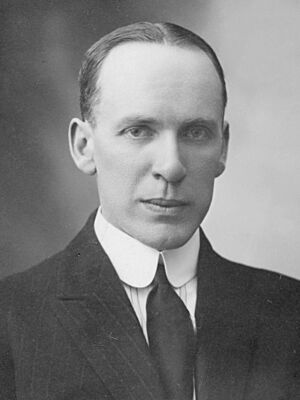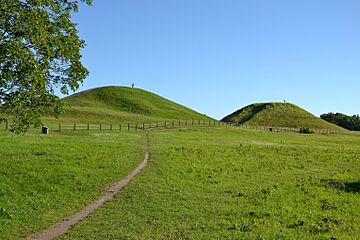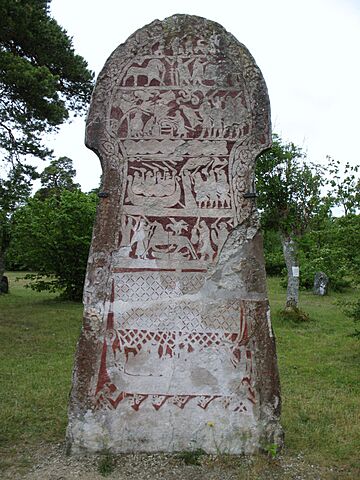Birger Nerman facts for kids
Quick facts for kids
Birger Nerman
|
|
|---|---|

Nerman in the 1920s
|
|
| Born | 6 October 1888 Norrköping, Sweden
|
| Died | 22 August 1971 (aged 82) Stockholm, Sweden
|
| Alma mater |
|
| Spouse(s) |
Zelma Nerman
(m. 1932) |
| Scientific career | |
| Institutions |
|
Birger Nerman (born October 6, 1888 – died August 22, 1971) was a famous Swedish archaeologist, historian, and philologist. He was an expert on the Iron Age in Sweden. The Iron Age was a time when people started using iron tools and weapons.
Nerman studied at Uppsala University. He started his career teaching about old Nordic languages. He also took part in digs, exploring sites from the Stone Age and Iron Age in Sweden. He was known for trying to combine clues from archaeology (digging up old things) and philology (studying old languages). He explored important places like Gamla Uppsala and Gotland.
From 1923 to 1925, Nerman was a professor of archaeology at the University of Dorpat in Estonia. He helped develop modern archaeology in Estonia. Later, he led digs in places like Grobiņa to learn about how Sweden and the eastern Baltic region were connected during the Iron Age.
Nerman became the director of the Swedish History Museum from 1938 to 1954. He organized many exhibitions about Swedish history. He was a Swedish patriot who was against both Nazism and Communism. He strongly supported the independence of the Baltic states. Nerman wrote many books about Iron Age archaeology and popular books about early Swedish history and culture.
Contents
Early Life and Education
Birger Nerman was born in Norrköping, Sweden, on October 6, 1888. His father, Janne Nerman, was a bookseller. His mother was Ida Nordberg.
In 1907, Nerman started studying philology at Uppsala University. Philology is the study of language in historical sources. He earned his doctorate degree in 1913. His main paper was called Svärges hedna litteratur, which means "Sweden's Pagan Literature." It was about an old poem called the Ynglingatal.
One of his teachers, Knut Stjerna, greatly influenced him. Nerman believed that old stories like Beowulf had roots in Swedish oral traditions. Other language experts criticized his paper because it used archaeological evidence. This made Nerman focus more on archaeology. However, he always believed that archaeology and philology should work together.
Early Career and Research

Nerman worked with Stjerna and later Oscar Almgren on archaeological research. They focused on the Swedish Stone Age and Iron Age. Nerman wanted to understand Iron Age Sweden better by combining language studies and archaeological finds. Many Swedish archaeologists and philologists liked his approach.
He took part in excavations at Gamla Uppsala, Vendel, and Adelsö. His work at Gamla Uppsala was done with Sune Lindqvist.

From 1914, Nerman spent more time on archaeological digs in Gotland and the Baltic states. He was very interested in how these areas were connected during the Iron Age. His books about Iron Age Gotland, some written with Almgren, became important guides for the subject.
At Uppsala University, Nerman became an assistant professor in 1917. He became a docent (a type of university lecturer) in 1919. During this time, he taught about Nordic languages, especially the sagas. In 1918, he earned another degree in prehistory.
Research in the Eastern Baltic Region
From 1923 to 1925, Nerman was a Professor of Archaeology at the University of Dorpat in Estonia. He helped set up the way modern archaeology is done in Estonia. His time in Dorpat was very important for his future studies. In 1924, he did archaeological research at Izborsk, Estonia.
While teaching, Nerman also wrote many books about Swedish history for general readers. In his books, he suggested that the Swedes had a strong state very early on. He believed they explored and settled in the eastern Baltic region during the Vendel Period. Nerman was a Swedish patriot, and his works showed his love for his country.
In 1929–1930, Nerman led excavations at Grobiņa, Latvia. He published the results in a book called Die Verbindungen zwischen Skandinavien und dem Ostbaltikum in der jüngeren Eisenzeit. He thought Grobiņa was founded by people from Sweden or Gotland. He believed it was the town of Seeburg mentioned in an old text. Scandinavian graves found by Nerman at Grobiņa date back to 650 AD. This means they are even older than the Viking Age. These discoveries encouraged Nerman to do more research at Apuolė and Wiskiauten in 1931.
Leading the Swedish History Museum
After returning from Dorpat, Nerman worked for the Swedish History Museum. He was its director from 1938 to 1954. He oversaw the renovation of the museum building. He also organized many popular exhibitions. Nerman worked hard to make the museum's collections easy for everyone to see and understand. He also continued to write books and give public talks.
Nerman was very active in groups that worked to protect Sweden's national heritage. He was the secretary (1929–1939) and chairman (1939–1969) of the Swedish Antiquarian Society. He cared deeply for the Baltic states and their people since his time as a professor in Estonia. He helped create the Baltic Institute. He was also the first chairman of the Baltic Committee. Nerman strongly supported the independence of the Baltic states. He also supported the rights of Balts and Estonians. During World War II, he was part of groups that were against anti-Nazi and anti-communist ideas.
Nerman retired from the Swedish History Museum in 1954. Even after retiring, he kept writing books about Swedish archaeology.
Personal Life
Birger Nerman married Zelma Nerman on January 21, 1932. He passed away in Stockholm on August 22, 1971. He was survived by his two daughters and several grandchildren.
See also
- Hector Munro Chadwick
- Jan de Vries (philologist)
- Herbert Jankuhn
- Anders Kaliff
- Gustaf Kossinna
- Magnus Olsen
- Eric Oxenstierna
- Gudmund Schütte

